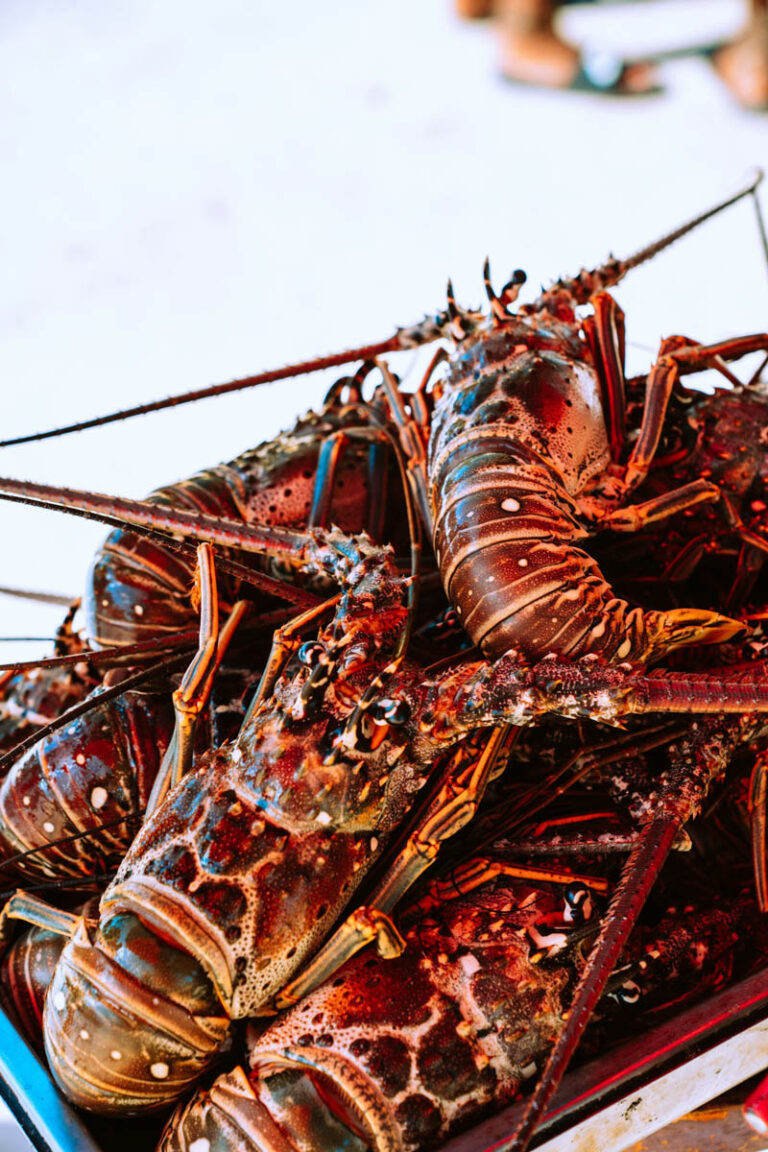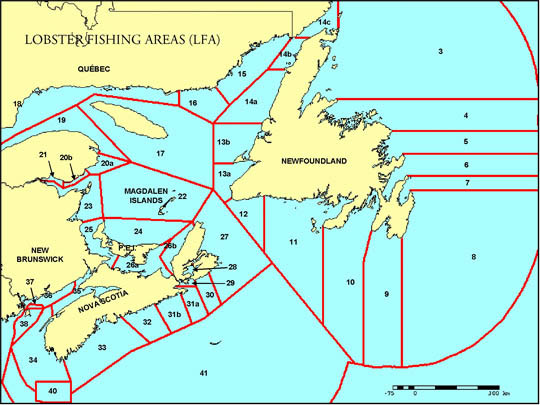Species at a Glance
Lobster is Canada’s most valuable seafood export and an iconic Canadian species exported around the world. Canadian lobster landings remain at one of the highest levels recorded in 100 years, with an upward trend over recent decades. The majority (78%) of Canadian lobster exports are destined for the United States. Other key markets include Asia (Japan and China) and the European Union (Belgium, France). Lobster is also exported to an additional 50 countries.
Fisheries and Oceans Canada manages 45 lobster fisheries, in which 10,000 licensed harvesters across Atlantic Canada and Quebec participate. Lobsters are caught using baited traps placed on the bottom of the sea. Overall, lobster populations in Canada are healthy and sustainably managed.
Landings:Annual lobster landings in 2013 were 74,686 tonnes. In 2012 lobster landings were 74,790 tonnes. In 2011, lobster landings were 66,500 tonnes.
Value:The lobster landed value was $680.5 million in 2013, $662.8 million 2012, and $619.7 million in 2011. Annual exports in 2011 were worth over $1 billion.
Abundance Status and Trends:Lobster landings are a primary indicator of abundance. There has been a general, upward trend in landings in recent decades. In 2009, the landings were 56,554 tonnes; the second highest on record in the last 20 years.
Fisheries:There are 45 lobster fisheries throughout the Atlantic Provinces and Quebec, including one for the offshore fishery and one closed for conservation.
Conservation Measures:These are tailored to meet the unique needs of each lobster fishery. Commonly used measures include limits to the number of licences, trap limits, length of fishing seasons, number of fishing days, total allowable catch quotas (in the offshore lobster fishing area), lobster size restrictions, and more.
Species Background
Sometimes growing to lengths of 60 cm and weighing over 18 kilograms, lobsters can grow to be among the largest marine crustaceans. They are also the longest-living crustaceans, capable of reaching ages of up to 50 years. The American lobster is distributed in the northwest Atlantic from the deeper waters of North Carolina to the waters of Newfoundland and southern Labrador. The largest populations are found in the Gulf of Maine and the southern Gulf St. Lawrence.
Lobsters are active hunters, feeding on a variety of animals, including crab, shellfish, marine worms, starfish, sea urchins and fish. Larval and post-larval lobsters are prone to predation by crabs and finfish species. When outside their burrows, juveniles are prey for many fish species. Lobsters become less vulnerable to predation as they grow, except during moulting periods when they shed their hard outer shell.
Fisheries
In Canada, about 10,000 licensed harvesters take part in 45 lobster fisheries (43 inshore with small-boat harvesters, one offshore and one closed to lobster fishing as a conservation measure (area 40)). Lobster fishing is most active in the Gulf of Maine, Bay of Fundy, Southern Gulf of St. Lawrence and coastal Nova Scotia. Lobsters are caught in baited traps placed on the bottom of the sea. Most fisheries take place in shallow waters less than 40 metres deep and within 15 km of shore, although some fisheries (areas 34-38) will fish much farther out and in waters up to 200 metres deep.
There is one Enterprise Allocation offshore lobster licence (area 41), which takes place in the deep basins and outer banks off southwestern Nova Scotia. The offshore lobster fishery season is year round, with a 720-tonne quota and the harvesters are not permitted to fish closer than 92 km from shore. This offshore fishery received eco-certification as a sustainable and well-managed fishery from the Marine Stewardship Council in June 2010.
Conservation Measures
The lobster fishery in Canada has one of the longest histories of regulation. Many of the management measures in place today date back over a century, with the first conservation measure – protection of egg-bearing females – put in place in the early 1870s.
Fisheries and Oceans Canada works closely with the lobster fishing industry to develop and update Integrated Fisheries Management Plans that cover the lobster fisheries. Management measures are tailored to the unique needs of each Lobster Fishing Area.
The inshore lobster fishery is managed by “input control,” which means that a limit is placed on fishing efforts. Conservation measures include:
- a limited number of licences issued, with limits on the number of traps;
- limited and staggered fishing seasons – lobster fishing is generally prohibited between July and the end of September to protect summer moults;
- protection of egg-bearing females – females bearing eggs must be released back into the environment alive to ensure the reproductive cycle continues (harvesters may voluntarily cut a small v-shaped notch in the female’s tail prior to release to ensure it will be released in the future, even when not bearing eggs);
- minimum lobster size limits – a measure to increase the likelihood that lobsters reach full adult maturity and reproduce;
- maximum lobster size limits (or a closed window size as an alternative measure) which protects large lobsters that proportionally produce more eggs;
- trap designs that allow undersized lobsters to escape and that include biodegradable escape panels to ensure traps lost at sea will not continue catching lobsters and other species; and
- ongoing monitoring and enforcement of fishing regulations and licence conditions.
The offshore lobster fishery in area 41 has many of the same conservation measures in place as well as an annual limit on the number of lobsters that may be caught, referred to as total allowable catch. The current total allowable catch for this fishery is 720 tonnes and has remained unchanged since 1989.
Population Estimates
Fisheries and Oceans Canada conducts regular stock assessments of lobster fisheries, using data collected from at-sea and port lobster samples, monitoring traps, harvester logbooks, trawl and diving surveys and, in some cases, video surveys. Information about the condition and status of the oceans is also collected to better understand the effect of environmental conditions on lobster populations.
Using these data, Fisheries and Oceans Canada looks at a variety of indicators to get a better understanding of the status of lobster, including:
- landings;
- catch rates and exploitation rates;
- sizes and weight of lobsters caught;
- abundance of pre-recruits and breeding females;
- male/female ratio and mating success; and
- production of one- and two-year old lobsters.
External experts and harvesters review our stock assessments and the results are published on our Canadian Science Advisory Secretariat Web Site.








